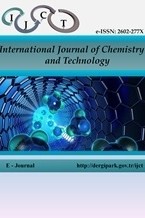Biodegradation of chlorpyrifos by bacterial genus pseudomonas putida
Biodegradation of chlorpyrifos by bacterial genus pseudomonas putida
Pesticides, Chlorpyrifos P. Putida, biodegradation,
___
- 1. Haktanır, K. A. Ü. Ziraat Fakültesi, T. no:107, 1985, Ankara.
- 2. Barlas, N. Tübitak 1996. Project: YDABÇAG 217/A.
- 3. Güler, Ç.; Uz, H.; Sur, H. TSE Standard Ekonomik ve Teknik Dergi,1998, 440(37), 54-59.
- 4. Ünlü, K.; Özenirler, G.; Sözüdoğru, S. Turkish J Eng Env Sci., 1997, 21, 189-202.
- 5. William, M.D.; Coates, J.A.; Garcia, K.L.; Signorella, L.L.; Delfino, J.J. J. Chromatogr. A, 1993, 643, 341-350.
- 6. Yıldırım, E. Tarımsal Zararlılarla Mücadele Yöntemleri ve Kullanılan İlaçlar. Atatürk Üniv. Ziraat Fak. Yayınları, No:219, Erzurum, 350 s. 2008.
- 7. Baltensweiler, W. Z. Ang. Ent., 1985, 99:77-85.
- 8. Güler, Ç.; Uz, H.; Sur, H. TSE Standard Ekonomik ve Teknik Dergi,1998, 440(37), 54-59.
- 9. Gürman, A. Kimya Mühendisliği Dergisi, 1993, 138. Sayı.
- 10. Öztürk, S. Tarım İlaçları, Hasat Yayıncılık, İstanbul. 1990.
- 11. Ecevit, O.; Bayraklı, F. Pestisit kalıntı sorunu ve Önemi, Çölleşen Dünya ve Türkiye Örneği, T.C. A.Ü. Çevre Sorunları Araştırma Merkezi, Erzurum. 13-17 Mayıs, 1985.
- 12. Güvener, A. Pestisit Kalıntı Sorunları, I. Ulusal Zirai Mücadele İlaçları Sempozyumu, DİE, Ankara.27-29 Kasım, 1980.
- 13. Türkiye Çevre Vakfı, 1995, Türkiye’nin Çevre Sorunları’95, Altıncı Baskı, Önder Matbaa, Ankara, 1995.
- 14. Ayas, Z.; Barlas, N.; Kolankaya, D. Aquat. Toxicol. 1997, 39(2)171-181.
- 15. İnce, N.; Bekbölet, M. Türkiye’de Pestisit Tüketimine İlişkin Kirlenme Öncelikleri, Türkiye’de Çevre Kirlenmesi Öncelikleri Sempozyumu, 21-22 Mayıs, İstanbul, 1991.
- 16. Falmann, H.; Krutzler, T.; Bauer, R.; Malato, S.; Blanco, J. Catal. Today, 1999, 54, 309-319.
- 17. Aksu, Z. Process Biochem 2005., 40, 997-1026.
- 18. Bellinaso, M. L.; Greeer, C. W.; Peralba, M. C. C.; Henriques, J.A.P; Gaylarde, C.C. FEMS Microbiol. Ecol. 2003, 43, 191-194.
- 19. Sanchez, M.E.; Estrada, I.B.; Martinez O.; Martin-Villacorta, J.; Aller, A.; Moran, A. Chemosphere, 2004, 57, 673-679.
- 20. Tutarlı, A. Elazığ’da Tarımsal Mücadele Amacıyla Kullanılan Pestisitlerin Topraktaki Kalıntılarının Araştırılması, Master's Dissertation, F.Ü. Fen Bilimleri Enstitüsü, Elâzığ, 1991.
- 21. Buitron, G.; Koeffed, A.; Capdeville, B. Envıron Technol, 993, 14, 227-236.
- 22. Barlas, N. Tübitak 1996. Project: YDABÇAG 217/A.
- Yayın Aralığı: Yılda 2 Sayı
- Başlangıç: 2017
- Yayıncı: İbrahim DEMİRTAŞ
Kenan ALTUN, Ümit YILDIKO, Aslıhan Aycan TANRIVERDİ, İsmail ÇAKMAK
Biodegradation of chlorpyrifos by bacterial genus pseudomonas putida
Bülent SARI, Hatice Şebnem KÜPELİ, Hakan GÜNEY, Olcayto KESKİNKAN
Jamaluddeen ABUBAKAR, Great EDO, Nur PASAOGLULARİ AYDİNLİK
Antioxidant activity of silver nanoparticles synthesized from Tagetes erecta L. leaves
Ramazan ERENLER, Esma Nur GEÇER, Nusret GENÇ, Dürdane YANAR
Resorcinol derivatives as human acetylcholinesterase inhibitor: An In Vitro and In Silico study
Production of organic light-emitting diode with fluorescence featured quinoline derivative
Mustafa DOĞAN, Ümit ERDEM, Salih ÖKTEN
Variation of components in laurel (Laurus nobilis L.) fixed oil extracted by different methods
